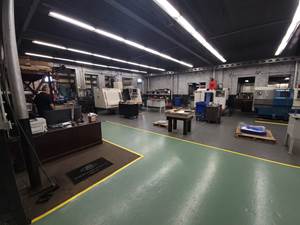Improving Productivity With Calibration
Shop managers have understood the benefits of volumetric calibration and compensation of machine tools for a while, but the technique rarely has been used because it has been too expensive and too complicated.
Share





Shop managers have understood the benefits of volumetric calibration and compensation of machine tools for a while, but the technique rarely has been used because it has been too expensive and too complicated. Optodyne, Inc., of Compton, California, is now offering a volumetric calibration and compensation system that can do volumetric calibration and compensation of a single machine in about 2 to 4 hours. Optodyne officials compare this to other methods that typically take 2 business days for volumetric calibration of a machine tool, with linear calibration often requiring a full 8 hours.
This system, consisting of the MCV-500 laser calibration equipment and SD-500 Vector measurement software, is priced in the $13,000 range, making it affordable for many medium sized shops.
According to Optodyne, a regularly calibrated machine ensures high repeatability. If the machining process is correct, the parts are correct—all of the parts. And this translates into higher productivity and cost-effectiveness. So the bottom line is driving the trend toward regular volumetric calibration and compensation of metalworking machines, Optodyne officials say.
At the heart of Optodyne's calibration system is Laser Doppler Displacement Meter technology. The system measures linear position errors, vertical straightness errors and horizontal straightness errors for all three linear axes. It also measures three squareness errors. When a machine tool's volumetric errors are measured, it can be compensated over the whole volume, which improves the overall accuracy of the machine tool, not simply its linear displacement, developers say. The Optodyne system can determine volumetric accuracy with only four body diagonal displacement measurements. According to the company, body diagonal displacement errors are sensitive to all the volumetric error components and therefore make an efficient test of volumetric accuracy.
The system needs four setups to detect nine sets of errors, based on efficient measurement of body diagonals. The working volume of a typical VMC has eight body diagonals, a diagonal being defined by starting at one corner of the base plane and moving to the opposite corner at the top plane. The positive or negative axis movement defines these body diagonals. The last four body diagonals are the same corners as the first four diagonals, except the directions are reversed.
Hence there are only four body diagonal directions with forward movement and reverse movement (bi-directional), and there are only four setups.
For each setup, the machine spindle movement along each of the diagonals is measured by first executing the X, then the Y, and finally the Z portion of the spindle travel. Readouts are taken and recorded at each intermediate step. This method demonstrates how three displacement errors, three vertical straightness errors and three horizontal straightness errors are measured with only four setups. For this reason, a three-axis machine tool with a one-meter cube volume can be checked in about 4 hours.
In many applications, fixtures and tooling do not have to be removed, and enclosures do not have to be dismantled. According to the company, the system is designed so that it can be set up and operated by shop floor personnel, with two to three hours needed to learn how.
By measuring volumetric errors, Optodyne's software can generate a compensation table, which can be downloaded to the control. The table compensates for errors detected in the machine tool's whole volume. Optodyne claims that the gain in accuracy reduces the bandwidth of errors by a factor of four, going from a typical volumetric error of 0.060 mm down to 0.015 mm.
Compensation file formats are available for Giddings & Lewis, Milltronics, Siemens 840, Fanuc 15 and Fanuc 16 controls, with others in development.
The Optodyne laser system is calibrated and traceable to NIST, and software analysis supports various industry standards such as ISO 230-2 and ASME B5.54. To make data collection and analysis easier, the MCV-500 can be connected to most Windows-compatible notebook or desktop computers through an RS 232 port. Windows supported software provided with the system enables automatic collection and analysis of data.
Related Content
From Tradition to Transformation: Century-Old Manual Machine Shop Adds CNCs
After 122 years of working with manual mills and lathes, this fifth-generation shop acquired assets of a local CNC machining business and hired the owner. Here’s how it’s going a year later.
Read MoreContinuous Improvement and New Functionality Are the Name of the Game
Mastercam 2025 incorporates big advancements and small — all based on customer feedback and the company’s commitment to keeping its signature product best in class.
Read More6 Machine Shop Essentials to Stay Competitive
If you want to streamline production and be competitive in the industry, you will need far more than a standard three-axis CNC mill or two-axis CNC lathe and a few measuring tools.
Read MoreHow this Job Shop Grew Capacity Without Expanding Footprint
This shop relies on digital solutions to grow their manufacturing business. With this approach, W.A. Pfeiffer has achieved seamless end-to-end connectivity, shorter lead times and increased throughput.
Read MoreRead Next
AMRs Are Moving Into Manufacturing: 4 Considerations for Implementation
AMRs can provide a flexible, easy-to-use automation platform so long as manufacturers choose a suitable task and prepare their facilities.
Read MoreMachine Shop MBA
Making Chips and 91ÊÓƵÍøÕ¾ÎÛ are teaming up for a new podcast series called Machine Shop MBA—designed to help manufacturers measure their success against the industry’s best. Through the lens of the Top Shops benchmarking program, the series explores the KPIs that set high-performing shops apart, from machine utilization and first-pass yield to employee engagement and revenue per employee.
Read MoreLast Chance! 2025 Top Shops Benchmarking Survey Still Open Through April 30
Don’t miss out! 91ÊÓƵÍøÕ¾ÎÛ's Top Shops Benchmarking Survey is still open — but not for long. This is your last chance to a receive free, customized benchmarking report that includes actionable feedback across several shopfloor and business metrics.
Read More






















